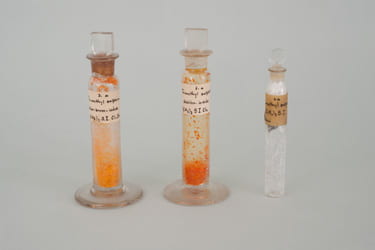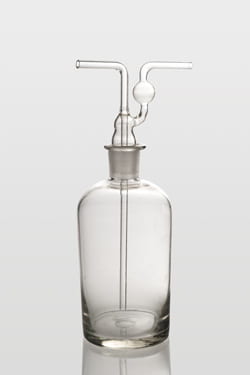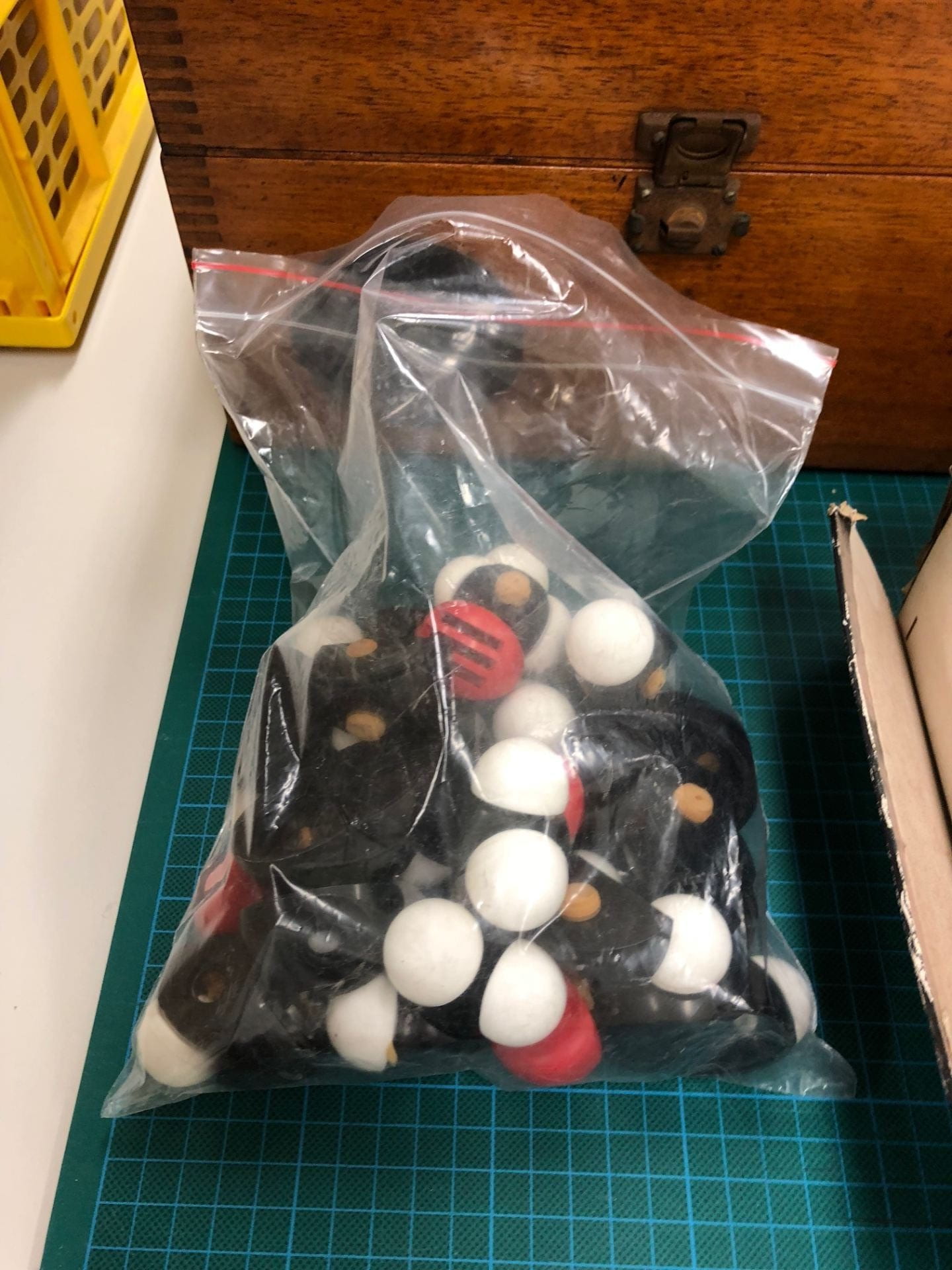
Cataloguing the University’s School of Chemistry Collection
Grimwade Centre student Lia Sumichan worked in the University of Melbourne’s School of Chemistry Collection as part of the University’s Museums and Collections Projects Program. She told Isabella Walker how unique collection items and inspiring colleagues encouraged a newfound passion for chemistry.
How did you get involved in the Museums and Collections Projects Program?
The University of Melbourne’s vast Cultural Collections are a treasure trove of unique and fascinating artefacts. The Grimwade Centre contributes to the care and conservation of these collections both through teaching and research, and through commercial services, including professional treatment and management programs. As part of this, Grimwade Centre students participate in the University’s Museums and Collections Projects Program (MCPP), which allows them to develop new skills related to their chosen field.
Each year, the MCPP gives members of the University community, including students and alumni, an opportunity to work with the University’s vast cultural collections. Interested volunteers are matched with one of the University’s collections and assist collection co-ordinators in a variety of collection management projects.

Why did you apply to work with the Chemistry Collection?
Out of all the projects available, the School of Chemistry Collection project was actually my first preference! This was because I really wanted to nurture my interest in chemistry. At that stage, I was about to start studying a Master of Cultural Materials Conservation. I knew I was going to be learning a lot about chemistry, which was something I didn’t know much about, and I thought that maybe this could be the way to become more familiar with it.
Also, the project involved cataloguing and rehousing items, which were conservation skills I was keen to explore and improve. The Chemistry Collection is mostly made up of objects, and although my conservation specialisation is in paintings, I knew that the cataloguing skills I would learn during the MCPP would be transferable to paintings.
Tell me about the Chemistry Collection.
The School of Chemistry Collection is made up of about 600 objects that were once used for teaching or research. The oldest instruments were used at the University in the 1850s, and many items have historical significance because of their association with early British and Australian chemists. The collection includes some really old equipment, like vintage Bunsen burners, glassware, measuring instruments – things like that. A few of these items are accompanied by manuals that outline their model number and how to use them. There were two metal drawers of paper catalogues and books – some of these were from the very beginning of the twentieth century. The collection even had some material samples that were once used for teaching – I mean samples of the chemicals themselves!

Are all the instruments and chemicals identified?
Not yet, not yet! Because most of the items in the collection were teaching aids, the details of their manufacture and acquisition weren’t comprehensively recorded. This means that, while the School of Chemistry has a lot of information about the items in the collection, there are still some significant instruments that are yet to be catalogued and added to the main collection.
Can you tell me a little about what exactly your project involved?
I started working with the collection in August 2018. Once a week, for about a year, I spent two or three hours cataloguing the collection with another volunteer, Nancy Ladas, who currently works at Melbourne Museum. Rob Ennis-Thomas, who is the Manager of Teaching Laboratories at the School of Chemistry, supervised the project.
Initially, we were given a description of the project that involved cataloguing and rehousing items that were yet to be integrated into the main collection. The project was going to build on earlier work undertaken by Dr Petronella Nel, a Senior Lecturer at the Grimwade Centre who is also an alumna of both the School of Chemistry and the Grimwade Centre. Her work included an inventory and significance assessment of the collection (2008), the curation of the inaugural Chemistry Collection Exhibition (2009), and six articles about the collection (2009–2011).
The main collection is located off campus, but the items awaiting rehousing and cataloguing are locked away on the second floor of the Chemistry building. I wouldn’t say the items are all over the place, but they’re kept in a number of different rooms on that floor, and they’re not terribly organised. The items were stored safely on shelves and in cabinets, but the catalogues and manuals were separated from the instruments. In order to store the collection safely, each of the items needed to be catalogued and then rehoused – which means stored – in a conservation-grade storage solution. To ensure that the objects maintained their provenance, they also needed to be matched to their manuals and manufacturing details.
With Nancy’s expertise, we started making a plan to work out what we would be able to achieve within the time frame. The first thing we had to do was inspect and identify the collection items to make it easy for us to catalogue them. For maximum efficiency, we decided to focus on the paper catalogues first. As we examined them, we wrote down their details so that we could match them to the corresponding instrument. Eventually, we would like the instruments and manuals to be rehoused together.

Does that mean you didn’t actually get to the rehousing process?
We did get to the rehousing process but were only able to rehouse a few items. This was because the cataloguing process was quite involved. We did a condition survey – which is a way of recording the condition and conservation requirements of a collection of objects – and even though we really only used a very quick condition checklist, it still took a long time because many of the items are unique.
One item could take us the whole two or three hours we had each week. This wasn’t because we were confused, but because we could have a whole discussion about each item. We had to note the kind of equipment and what it is made of, and provide a description of the item – and neither of us had any knowledge of chemistry before the project so we were seeing these objects from a layperson’s point of view. Most of the time Rob was occupied with other things, because his role involves managing all of the School’s Teaching Laboratories; however, when he was there, he was very helpful because he knew what each object was and he could give us its background. Once, for example, he even had an email from a professor that explained the purpose of a particular glass apparatus we couldn’t identify (it turned out to be a Kipp’s apparatus, which was once used to prepare small amounts of gas!).

Are there plans to exhibit the collection in future?
That’s a good question! The School already maintains a small rotating exhibition of collection items on the ground floor of the School of Chemistry building. So, at this stage, I think the School is largely concerned about getting the whole collection catalogued and rehoused so that it can be stored safely. Ultimately, they plan to move most of the items to a storage facility, which is somewhere off-campus.
How did your studies at the Grimwade Centre help give you the skills you needed to undertake this project?
At the very beginning of my conservation studies, I was introduced to the idea of a condition report, including the right terminology to use and the expected template for such a report. While we were given a template to use for our condition report of the Chemistry Collection, I think that having a student conservator there was still really helpful: I could use what I had learnt to guide how we look at each object, how we record its condition, and how we classify its condition. Although Nancy works in a museum, she’s not a conservator – we were able to have a really open discussion and share our knowledge, including what I’ve learnt at the Grimwade, to answer the questions: is the condition of this item good? Is it poor? How do we decide?
So your condition reporting experience was really useful. What about rehousing? Were you able to use rehousing skills you had learnt at the Grimwade Centre?
We only ended up rehousing one item, which was a pH meter made of wood. By the time we got to this stage in our project, I had learnt how to make boxes in a Preventive Conservation subject. We had been taught how to make rehousing storage boxes out of archival-grade cardboard to fit the dimensions of the object to be stored. You actually need to be really precise when making these boxes, and you often need to craft internal supports out of conservation-grade foam to ensure that the item won’t move when the box is transported. Another student had recommended a specific kind of scalpel to use when making boxes, which was also very helpful. Rob supplied that particular scalpel blade to go with the tool box we had.

How did the project help you develop skills that are necessary for you as an emerging conservator?
We didn’t really have a lot of resources to use to progress this project, so one thing I learnt was how to make the most out of common programs like Excel when you have to work within a tight budget.
I think it was also useful to practise examining objects – to learn what to focus on, how to record what we see, how to give each item an accession number and so on. I also learnt that we already have a lot of information about each item from the papers and the objects themselves. Nancy would always point out that the manuals were very important: once we had matched a manual to a piece of equipment, it was enormously useful for providing provenance and significance.
I also learnt that teamwork is essential for getting the most out of a project: when we encountered an object we weren’t familiar with, Nancy and I – and Rob and other members of the School of Chemistry – would discuss it and share our varied knowledge and experience before we decided how to best move forward with the item. For example, Nancy and I came across a number of plastic models, which were in pretty bad condition, and we weren’t sure what to do with them or how to rehouse them. We weren’t even sure whether they were safe for us to handle – some older plastics emit dangerous gasses as they deteriorate. We ended up asking different people for their advice: I asked Dr Petronella Nel, now working at the Grimwade Centre, and Nancy asked her colleague at the museum. After we had canvassed opinion, Rob ended up taking a sample from the plastic models to examine using the School of Chemistry’s FTIR machine, which can identify materials by analysing very small samples under infrared light. We looked at the spectra produced by the FTIR, and from there we knew what materials we were dealing with and how to rehouse them safely.

You said earlier that one of the things that drew you to the Chemistry Collection was that you wanted to develop more of a passion for chemistry. Did you achieve that? Did you learn more about chemistry?
Yes, I think so. But I learnt more about chemistry from the people I was working with than from the collection itself. When we came across the plastic models, Rob was very generous and took Nancy and I to see first-hand how to analyse a sample using FTIR. I also remember that, one time, Rob had a guest from somewhere and they were about to do an experiment and he was like “You should come along!” Rob is very keen to share, and very supportive as well. It was quite amazing to see how Rob and the other Chemistry staff members were so passionate about chemistry itself, and wanted to teach us and invite us to learn more – their passion inspired my passion!
So it was actually the people that encouraged your interest in chemistry, rather than the collection itself!
Commitment can be a very hard thing to follow through on. Nancy and I enjoyed working on the Chemistry Collection, and we really looked forward to our Friday meeting – and I think that our commitment to the project was really because of the people, who made the whole thing fun and rewarding. Establishing relationships and making it fun keeps the commitment going.

Where did you get up to at the end of the project – how much of the project had you completed?
We created a template that can be used for further cataloguing, and finished cataloguing all the instruction manuals. They’re now all alphabetically organised – so hopefully nothing happens to the drawer where we organised them! We also rehoused one object and catalogued five objects. Everything is on the Excel spreadsheet and ready for the next MCPP team to begin!
Would you recommend the program to other student conservators?
Definitely! Especially for students specialising in the conservation of objects, because now that we’ve got all the papers and supplementary files out of their way, they can jump straight into the rehousing stage of the project. Also, there are so many unique items in the collection, things that students have probably never seen before, and I think these objects would be interesting for anyone studying conservation or chemistry.
Applications for the Museums and Collections Projects Program are accepted twice a year, usually in late March and late August. You can find out more about the work of MCPP, including Lia’s work, in the 2018 eNewsletter, available in pdf form here.
Feature image: Lia Sumichan at work, cleaning a painting at the Grimwade Centre (detail)